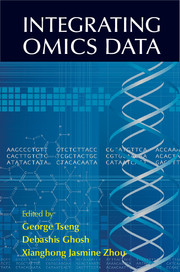Book contents
- Frontmatter
- Contents
- Contributors
- Introduction
- Part A Horizontal Meta-Analysis
- Part B Vertical Integrative Analysis (General Methods)
- Part C Vertical Integrative Analysis (Methods Specialized to Particular Data Types)
- 12 eQTL and Directed Graphical Model
- 13 MicroRNAs: Target Prediction and Involvement in Gene Regulatory Networks
- 14 Integration of Cancer Omics Data into a Whole-Cell Pathway Model for Patient-Specific Interpretation
- 15 Analyzing Combinations of Somatic Mutations in Cancer Genomes
- 16 A Mass-Action-Based Model for Gene Expression Regulation in Dynamic Systems
- 17 From Transcription Factor Binding and Histone Modification to Gene Expression: Integrative Quantitative Models
- 18 Data Integration on Noncoding RNA Studies
- 19 Drug-Pathway Association Analysis: Integration of High-Dimensional Transcriptional and Drug Sensitivity Profile
- Index
- Color plates
16 - A Mass-Action-Based Model for Gene Expression Regulation in Dynamic Systems
from Part C - Vertical Integrative Analysis (Methods Specialized to Particular Data Types)
Published online by Cambridge University Press: 05 September 2015
- Frontmatter
- Contents
- Contributors
- Introduction
- Part A Horizontal Meta-Analysis
- Part B Vertical Integrative Analysis (General Methods)
- Part C Vertical Integrative Analysis (Methods Specialized to Particular Data Types)
- 12 eQTL and Directed Graphical Model
- 13 MicroRNAs: Target Prediction and Involvement in Gene Regulatory Networks
- 14 Integration of Cancer Omics Data into a Whole-Cell Pathway Model for Patient-Specific Interpretation
- 15 Analyzing Combinations of Somatic Mutations in Cancer Genomes
- 16 A Mass-Action-Based Model for Gene Expression Regulation in Dynamic Systems
- 17 From Transcription Factor Binding and Histone Modification to Gene Expression: Integrative Quantitative Models
- 18 Data Integration on Noncoding RNA Studies
- 19 Drug-Pathway Association Analysis: Integration of High-Dimensional Transcriptional and Drug Sensitivity Profile
- Index
- Color plates
Summary
Abstract
Although joint analysis of multiple omics data sets is often discussed in the context of analyzing large-scale genomic data in clinical or population studies, data integration is also useful for systems biology studies that investigate biological mechanisms in model systems under controlled environment. In this chapter, a model-based method is developed to simultaneously analyze time course transcriptomic and proteomic data sets to quantitatively dissect the contribution of RNA-level and protein-level regulation to the variation in gene expression. The statistical method is based on a mass-action-based model for protein synthesis and degradation rates of individual genes, and change points in the stochastic process of the kinetic parameters are derived to identify distinct patterns of regulation of gene expression in time course profiles. A sampling-based inference procedure using Markov chain Monte Carlo is implemented, and the posterior probabilities of change points in the ratio of protein synthesis and degradation are used to control the Bayesian false discovery rate. The method is illustrated using a yeast data set monitoring mRNA and protein expression in hyperosmolarity shock, where stress response functions are immediately invoked by up-regulation at the mRNA and protein levels and translational machinery is shut down in the early time points but reactivated later in time points at the protein levels.
Introduction
The process of RNA synthesis (transcription) is closely related with protein synthesis (translation) according to the central dogma of molecular biology (Crick, 1970). Considering gene expression as an array of biochemical processes to produce gene products, regulation of gene expression is a highly complex mechanism with multiple access points through transcriptional, posttranscriptional, translational, and posttranslational regulations. For instance, when cells encounter environmental stress, they are challenged to reprogram the transcriptome first (all messenger RNAs) to confer increased viability and fitness in the new environment and further adjust protein expression and additional posttranslational regulations (Causton et al., 2001). However, the dynamic relationship between the transcriptome and the proteome has remained elusive due to the lack of technology to measure protein expression at a scale comparable to gene expression, and it is of great interest to investigate how much of transcriptional and translational regulation determines the fate of the final gene products (Warringer et al., 2010; Garre et al., 2012).
- Type
- Chapter
- Information
- Integrating Omics Data , pp. 362 - 379Publisher: Cambridge University PressPrint publication year: 2015
- 1
- Cited by



